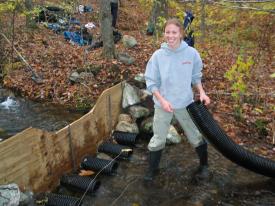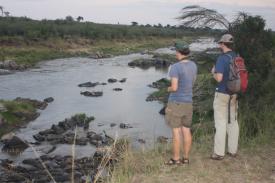Environmental change
A variety of projects in the Post Lab address the impacts of environmental change on community structure and ecosystem function. Core areas of study include: a) the role of discharge variation on community structure and ecosystem function in rivers and streams, and b) how changes in the rates of warming in seasonal systems like lakes influence consumer-resource dynamics.
Discharge variation
Influence on community structure
 Discharge is a master variable that determines to a great extent community structure and ecosystem function in rivers and streams. Discharge is inherently variable within and among years and is strongly influenced by human activities and climate change. For example, the construction of dams and diversion of water for consumptive use have greatly altered flow in many aquatic ecosystems and create considerable management difficulties for many fish populations. Furthermore, most climate change scenarios predict increased hydrologic variability, including a greater frequency of extreme events such as floods and droughts. This paradigm is well supported for high flow events (floods), but the impact of low flow events are not as well studies.
Discharge is a master variable that determines to a great extent community structure and ecosystem function in rivers and streams. Discharge is inherently variable within and among years and is strongly influenced by human activities and climate change. For example, the construction of dams and diversion of water for consumptive use have greatly altered flow in many aquatic ecosystems and create considerable management difficulties for many fish populations. Furthermore, most climate change scenarios predict increased hydrologic variability, including a greater frequency of extreme events such as floods and droughts. This paradigm is well supported for high flow events (floods), but the impact of low flow events are not as well studies.
For her dissertation research, Annika Walters conducted a replicated whole stream experiment in which she induced ~60-100 year low flow events in 100m stream reaches in Connecticut. Annika then asked how these flow diversions influence community structure and ecosystem function. Her experiments are among the first to explicitly test low flow events. She showed that low flow events had strong impacts on food web structure, but not on food-chain length (Walters and Post 2009). Her results also show quite clearly that stream community structure was relatively insensitive to a wide range of flow variation, but quite sensitive to extremely low flow events (Walters and Post 2011, Walters 2011). This type of effect had been hypothesized, but not well demonstrated for low flow events in streams. Annika’s research was supported by a grant from the National Science Foundation, a US EPA STAR graduate fellowship, Teresa Heinz Scholars for Environmental Research Award, and the Yale Institute for Biospheric Studies.
The Post Lab has also helped developed methods for quantifying discharge variation (Sabo and Post 2008) and test influence of discharge variation on food web structure (Sabo et al. 2010)
Interactions with nutrient loading
 Working on the Mara River in east Africa, Amanda Subalusky, Christopher Dutton, and David Post are working with collaborator Emma Rosi-Marshall to understand how river discharge interacts with nutrient loading by animal to influence ecosystem function. The Mara River passes through Kenya’s Maasai Mara National Reserve (MMNR) and Tanzania’s Serengeti National Park before entering Lake Victoria. The Mara sustains the largest remaining overland migration in the world of 1.5 million wildebeest (Connochaetes taurinus) and a population of over 4,000 hippos (Hippopotamus amphibius). During the migration (July – November), wildebeest provide a major subsidy to the river in the form of carcasses through periodic mass drowning events of thousands of individuals. Hippos provide a constant subsidy to the system in the form of nutrient elimination (egestion and excretion) from grass consumed in the surrounding terrestrial system and defecated into the river, transferring 9 tons/hippo/year of terrestrial biomass to the river
Working on the Mara River in east Africa, Amanda Subalusky, Christopher Dutton, and David Post are working with collaborator Emma Rosi-Marshall to understand how river discharge interacts with nutrient loading by animal to influence ecosystem function. The Mara River passes through Kenya’s Maasai Mara National Reserve (MMNR) and Tanzania’s Serengeti National Park before entering Lake Victoria. The Mara sustains the largest remaining overland migration in the world of 1.5 million wildebeest (Connochaetes taurinus) and a population of over 4,000 hippos (Hippopotamus amphibius). During the migration (July – November), wildebeest provide a major subsidy to the river in the form of carcasses through periodic mass drowning events of thousands of individuals. Hippos provide a constant subsidy to the system in the form of nutrient elimination (egestion and excretion) from grass consumed in the surrounding terrestrial system and defecated into the river, transferring 9 tons/hippo/year of terrestrial biomass to the river
 We expect these subsidies to interact strongly with discharge. The Mara has a seasonal flow regime, with high flows occurring during both the long rains (March-May) and the short rains (Nov. – Dec.). Input rates for hippos are generally consistent across varying flow levels; however, flow influences concentration, transport, and the relative effect of subsidies on river function. Inputs from wildebeest are likely to be greatest when river discharge is high, as large mortality events are typically caused by panic, trampling, and drowning that occur during high flows; however, these subsidies are periodic and likely have shorter-term effects on the Mara than hippo inputs. This research is supported by the National Science Foundation, the National Geographic Society, a Switzer Fellowship to Amanda Subalusky, and the Yale Institute of Biospheric Studies. For more information on this project, please see our Mara River Project web site.
We expect these subsidies to interact strongly with discharge. The Mara has a seasonal flow regime, with high flows occurring during both the long rains (March-May) and the short rains (Nov. – Dec.). Input rates for hippos are generally consistent across varying flow levels; however, flow influences concentration, transport, and the relative effect of subsidies on river function. Inputs from wildebeest are likely to be greatest when river discharge is high, as large mortality events are typically caused by panic, trampling, and drowning that occur during high flows; however, these subsidies are periodic and likely have shorter-term effects on the Mara than hippo inputs. This research is supported by the National Science Foundation, the National Geographic Society, a Switzer Fellowship to Amanda Subalusky, and the Yale Institute of Biospheric Studies. For more information on this project, please see our Mara River Project web site.
Rates of warming
Understanding how climate change will alter interactions among species is one of the 21st Century challenges for ecology. In lakes, climate warming is decreasing the length and severity of winters, increasing the density of over-wintering Daphnia and altering the rate of water column warming through the spring and early summer. Derek West is studying how these changes interact with lake nutrient status to influence consumer-resource dynamics between Daphnia and algae. Daphnia are the dominant grazers in lakes and the interaction between Daphnia and algae is critically important for water clarity, nutrient dynamics, and energy flow to upper trophic levels. Derek’s research is addressing fundamental questions about alternate states and the influence of climate change in lakes. This research is supported by the National Science Foundation and the Yale Institute of Biospheric Studies.
Related publications (Post Lab publications):
West, D.C. and D.M. Post. 2016. Impacts of warming revealed by linking resource growth rates with consumer functional responses. Journal of Animal Ecology 85:671–680. doi:10.1111/1365-2656.12491
Casey, M.M., G.P. Dielt, D.M. Post, and D.E.G. Briggs. 2014. The impact of eutrophication and commercial fishing on molluscan communities in Long Island Sound, USA. Biological Conservation 170:137-144. doi:10.1016/j.biocon.2013.12.037
Walters, A. W., and D. M. Post. 2011. How low can you go? Impacts of a low flow disturbance on aquatic insect communities. Ecological Applications 21:163–174. doi:10.1890/09-2323.1
Walters, A.W. 2011. Resistance of aquatic insects to a low-flow disturbance: exploring a trait-based approach. J. North American Benthological Society 30:346-356. doi:10.1899/10-041.1
Sabo, J.L., J.C. Finlay, T. Kennedy, and D.M. Post. 2010. The role of discharge variation in scaling of drainage area and food chain length in rivers. Science 330:965-967. doi:10.1126/science.1196005
Walters, A.W. and D.M. Post. 2008. An experimental disturbance alters fish size structure, but not food chain length in streams. Ecology 89:89:3261-3267.
Sabo, J. L. and D. M. Post. 2008. Quantifying periodic, stochastic and catastrophic variation in the environment using time series of environmental conditions. Ecological Monographs 78:19-40.